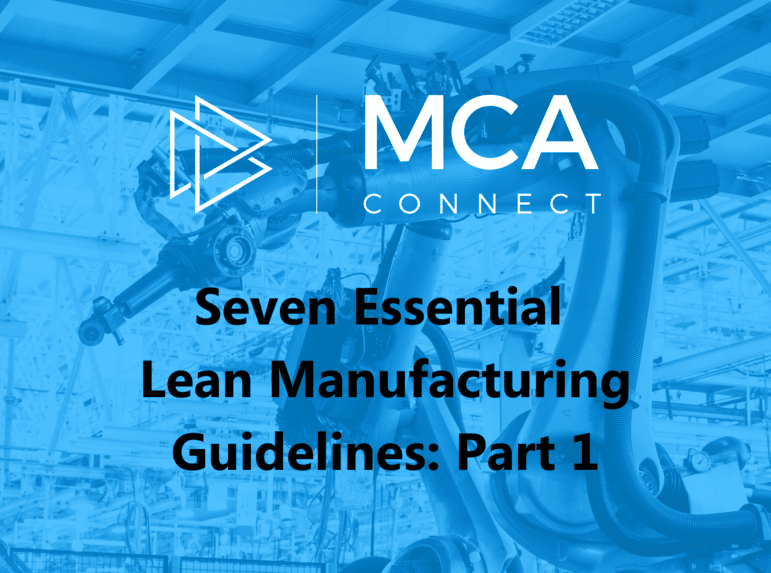All manufacturers know that lean manufacturing is an essential component of manufacturing excellence. The drive to remove waste has streamlined operations, eliminated idle inventory, and helped enable continuous process improvement. This 3-part blog series will outline seven essential guidelines for manufacturers to consider during the design of a future state value stream. These guidelines include:
- Produce to your takt time.
- Develop continuous flow wherever possible.
- Use supermarkets to control production where continuous flow does not extend upstream.
- Send the customer schedule to only one production process.
- Level the production mix by distributing the production of different products evenly overtime at the pacemaker process.
- Level the production volume by releasing and withdrawing small, consistent increments of work at the pacemaker.
- Develop the ability to make “every part every day” (then every shift, then every hour, or pallet or pitch) upstream of the pacemaker process.
You don’t hear about these guidelines very much these days. The lean manufacturing talking points have shifted away from “tools” toward an emphasis on “culture”. I think that we miss many of the concrete bottom-line benefits of lean when we ignore these key principles. But that’s a discussion for another day…
Let’s talk about production scheduling
Working with many complex manufacturers, I have found the production schedule to be a huge challenge. Some manufacturers use point solutions or customize to try to get their schedule to work smoothly. Other organizations have just given up on rigorous production scheduling and adopt a “launch and hope” approach (it’s a bit hard to call it a strategy). They count on the firefighting skills of their most senior workers to get products out the door.
However, when the business volume is high enough, the production schedule must be automated, and operations must be in control all of the time. Because they cannot afford to suffer a shop floor meltdown, these companies are continually exploring various operational excellence initiatives.
As we work with these high-volume and high-mix manufacturers, part of our job is to help design their future states. We specifically focus on their production scheduling. Our criteria to evaluate a future-state design are those lean design guidelines – but applied to a high mix world.
-
Takt Time
What exactly is takt time?
Takt time is the rate at which customers order your products. That classic definition sounds easy, but in high-mix manufacturing, customers order some products frequently and others infrequently.
The truest way to produce to takt time is to make-to-order (MTO). By making to order, you prevent overproduction which is the costliest waste. So MTO is always the ideal state. Pure MTO can be hard to achieve with high on-time delivery due to the inevitable spikes and dips in demand and the varying mix of products ordered.
The challenge with shortening the production schedule
As companies get leaner in operations, the production schedule length can drop from a week to daily to even every few hours. Shorter production schedules create a challenge because they reduce the flexibility of the value stream to respond to dips and spikes in demand. Flexibility is key to being able to build to takt time for high-mix manufacturers.
-
Why it’s important to design your lean future state to continuously flow
What is flow?
Flow is manufacturing production that is done one piece at a time, from process to process, without stopping. The lean manufacturing industry ideal state is to have a one-piece flow with a batch size of one.
CFOs often want to look at asset utilization and labor efficiency rates. However, in a manufacturing operation, optimizing for these two metrics can be a mistake because you have to:
- Process large batches that reduce the downtime required for changeovers.
- Isolate each process so it can run independently.
- Create an inventory buffer so there’s always work for the operator and machine to do.
- Optimize for efficiency which frees the operator from any upstream interruptions but at quite a cost.
Moving to flow instead
Moving to flow reduces inventory and lead time and can contribute to reductions in scrap and rework. Flow forces a “horizontal” view of the interrelationships between manufacturing processes rather than a more silo-ed vertical view. That’s why flow exposes all kinds of process problems, highlighting every issue that forces a stoppage anywhere in the flow line. Equipment breakdowns, changeovers, yield issues, even bill of material inaccuracies will stop a line from producing. These same issues also impact production in a traditional manufacturing environment, but the issues remain hidden behind big piles of inventory.
-
Use supermarkets to control production where continuous flow does not extend upstream
Ideally, in a lean manufacturing environment, every operation flows from the first, but that may not be possible due to limitations that you just can’t get around. That’s not to say that we don’t continually poke and prod these limits, but we’re often up against what our production equipment can support.
What limits continuous flow?
Typical factors that prevent flow include:
- Changeover times
- Inherent batch requirements
- Limitations of resources
Now you can calculate targeted stock levels for supermarket items.
Because you have a supermarket, you are back to a make-to-stock (MTS) scenario. As such, you can calculate a targeted stock level from actual history, forecasted demand, lead time, and safety time, understanding the service level of the inventory you must support. The service level reflects the level of stockouts that you are willing to allow. There is a direct relationship between the amount of inventory, the lumpiness of spikes and dips in demand, and your tolerance for disruption to downstream processes due to stockouts. This calculation of the targeted stock level lets the team know how many kanbans are needed.
Stay Tuned!
Stay tuned for part 2 (of 3) on this series about the Seven Essential Lean Manufacturing Guidelines. In the next post, we’ll talk about:
- Sending the customer schedule to only one production process.
- Leveling the production mix by distributing the production of different products evenly overtime at the pacemaker process.
Contact us if you’d like to discuss more about lean manufacturing.

